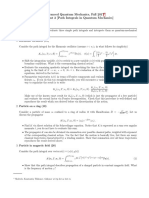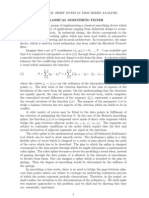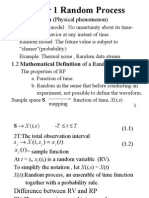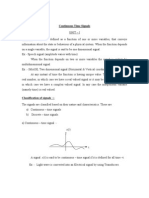Lecture VIII: Fourier Series: Maxim Raginsky
Lecture VIII: Fourier Series: Maxim Raginsky
Uploaded by
Shakil Safin OrthoCopyright:
Available Formats
Lecture VIII: Fourier Series: Maxim Raginsky
Lecture VIII: Fourier Series: Maxim Raginsky
Uploaded by
Shakil Safin OrthoOriginal Title
Copyright
Available Formats
Share this document
Did you find this document useful?
Is this content inappropriate?
Copyright:
Available Formats
Lecture VIII: Fourier Series: Maxim Raginsky
Lecture VIII: Fourier Series: Maxim Raginsky
Uploaded by
Shakil Safin OrthoCopyright:
Available Formats
Lecture VIII: Fourier series
Maxim Raginsky
BME 171: Signals and Systems
Duke University
September 19, 2008
Maxim Raginsky Lecture VIII: Fourier series
This lecture
Plan for the lecture:
1
Review of vectors and vector spaces
2
Vector space of continuous-time signals
3
Vector space of T-periodic signals
4
Complete orthonormal systems of functions
5
Trigonometric Fourier series
6
Complex exponential Fourier series
Maxim Raginsky Lecture VIII: Fourier series
Review: vectors
Recall vectors in n-space R
n
. Each such vector u can be uniquely
represented as a linear combination of n unit vectors e
1
, . . . , e
n
:
u =
1
e
1
+
2
e
2
+ . . . +
n
e
n
,
where
1
, . . . ,
n
are real numbers (coecients). These can be
computed using the scalar (or dot) product as follows:
k
= u e
k
, k = 1, . . . , n
Note that the vectors e
1
, . . . , e
n
are:
normalized e
k
e
k
= 1 for all k
orthogonal e
k
e
m
= 0 for k = m
e
1
e
2
u
v
x
y
6.5 3
3
5
0
Example: u, v in R
2
u = 3e
1
+ 5e
2
v = 6.5e
1
+ 3e
2
Maxim Raginsky Lecture VIII: Fourier series
Vector spaces
By denition, vectors are objects that can be added together and
multiplied by scalars:
if u =
n
k=1
k
e
k
and v =
n
k=1
k
e
k
, then we can form their sum
u +v =
n
k=1
(
k
+
k
)e
k
if u =
n
k=1
k
e
k
and is a scalar, then we can form the vector
u =
n
k=1
k
e
k
More generally, a collection of objects that can be added and/or
multiplied by scalars is called a vector space.
Maxim Raginsky Lecture VIII: Fourier series
Signal spaces
We have already seen one example of a vector space the space of
continuous-time signals. We can easily verify:
we can form the sum of any two signals x
1
(t) and x
2
(t) to get
another signal
x(t) = x
1
(t) + x
2
(t)
we can multiply any signal x(t) by a constant c to get another signal
z(t) = cx(t)
Unlike the n-space R
n
, the vector space of all continuous-time signals is
huge. In fact, it is innite-dimensional.
Maxim Raginsky Lecture VIII: Fourier series
The space of periodic signals
Let us consider all T-periodic signals. Any such signal x(t) satises
x(t + T) = x(t) for all t
for some given T > 0.
It is easy to see that T-periodic signals form a vector space:
if x
1
(t) and x
2
(t) are T-periodic, then
x
1
(t + T) + x
2
(t + T) = x
1
(t) + x
2
(t),
so their sum is T-periodic
if x(t) is T-periodic, then
cx(t + T) = cx(t),
so any scaled version of x(t) is also T-periodic
If we impose even more conditions on our T-periodic signals (the
so-called Dirichlet conditions, which hold for all signals encountered in
practice), then we can represent signals as innite linear combinations of
orthogonal and normalized (orthonormal) vectors.
Maxim Raginsky Lecture VIII: Fourier series
Complete orthonormal sets of functions
First of all, we can dene a scalar (or dot) product of two T-periodic
signals x
1
(t) and x
2
(t) as
x
1
, x
2
=
_
T
0
x
1
(t)x
2
(t)dt
(note that we can integrate over any whole period, not necessarily from
t = 0 to t = T).
Then we can take any sequence of T-periodic functions (signals)
0
(t),
1
(t),
2
(t), . . . that are
1
normalized:
k
,
k
=
_
T
0
2
k
(t)dt = 1
2
orthogonal:
k
,
m
=
_
T
0
k
(t)
m
(t)dt = 0 if k = m
3
complete: if a signal x(t) is such that
x,
k
=
_
T
0
x(t)
k
(t)dt = 0 for all k, then x(t) 0
Maxim Raginsky Lecture VIII: Fourier series
Fourier series
Let {
k
(t)}
k=1
be a complete, orthonormal set of functions. Then any
well-behaved T-periodic signal x(t) can be uniquely represented as an
innite series
x(t) =
k=0
k
(t).
This is called the Fourier series representation of x(t). The scalars
(numbers)
k
are called the Fourier coecients of x(t) (with respect to
{
k
(t)}) and are computed as follows:
k
= x,
k
=
_
T
0
x(t)
k
(t)dt
In analogy to vectors in n-space, you can think of
k
as the projection
(or component) of x(t) in the direction of
k
(t).
Maxim Raginsky Lecture VIII: Fourier series
Fourier coecients
To derive the formula for
k
, write
x(t)
k
(t) =
m=0
m
(t)
k
(t),
and integrate over one period:
_
T
0
x(t)
k
(t)dt
. .
x,
k
=
_
T
0
_
m=0
m
(t)
k
(t)
_
dt
=
m=0
m
_
T
0
m
(t)
k
(t)dt
. .
m
,
k
=
k
,
where in the last line we use the fact that {
k
} form an orthonormal
system of functions.
Maxim Raginsky Lecture VIII: Fourier series
Convergence of Fourier series
It can be proved that, because the functions {
k
} form a complete
orthonormal system, the partial sums of the Fourier series
x(t) =
k=0
k
(t)
converge to x(t) in the following sense:
lim
N
_
T
0
_
x(t)
N
k=1
k
(t)
_
2
dt = 0
So, we can use the partial sums
x
N
(t) =
N
k=1
k
(t)
to approximate x(t).
Maxim Raginsky Lecture VIII: Fourier series
Trigonometric Fourier series
Fact: the sequence of T-periodic functions {
k
(t)}
k=0
dened by
0
(t) =
1
T
and
k
(t) =
_
_
_
_
2
T
sin(k
0
t), if k 1 is odd
_
2
T
cos(k
0
t), if k > 1 is even
is complete and orthonormal. Here,
0
=
2
T
is called the fundamental frequency. Orthonormality is quite easy to
show, completeness not so much.
Thus, any well-behaved T-periodic signal x(t) can be represented as an
innite sum of sinusoids (plus a constant term
0
0
):
x(t) =
k=0
k
(t)
Maxim Raginsky Lecture VIII: Fourier series
Trigonometric Fourier series
A more common way of writing down the trigonometric Fourier series of
x(t) is this:
x(t) = a
0
+
k=1
a
k
cos(k
0
t) +
k=1
b
k
sin(k
0
t)
Then the Fourier coecients can be computed as follows:
a
0
=
1
T
_
T
0
x(t)dt
a
k
=
2
T
_
T
0
x(t) cos(k
0
t)dt
b
k
=
2
T
_
T
0
x(t) sin(k
0
t)dt
Recall that
0
= 2/T.
Maxim Raginsky Lecture VIII: Fourier series
Trigonometric Fourier series
To relate this to the orthonormal representation in terms of the
k
, we
note that we can write
a
0
=
1
T
_
T
0
x(t)
0
(t)dt =
1
0
a
k
=
_
2
T
_
T
0
x(t)
2k
(t)dt =
_
2
T
2k
b
k
=
_
2
T
_
T
0
x(t)
2k1
(t)dt =
_
2
T
2k1
Thus, we have
x(t) = a
0
+
k=1
a
k
cos(k
0
t) +
k=1
b
k
sin(k
0
t)
=
1
T
0
(t) +
_
2
T
_
k=1
2k
_
T
2
2k
(t) +
k=1
2k1
_
T
2
2k1
(t)
_
=
k=1
k
(t)
Maxim Raginsky Lecture VIII: Fourier series
Symmetry properties
Things to watch out for when computing the Fourier coecients:
if x(t) is an even function, i.e., x(t) = x(t) for all t, then all its
sine Fourier coecients are zero:
b
k
=
2
T
_
T/2
2/T
x(t) sin(k
0
t)dt = 0
if x(t) is an odd function, i.e., x(t) = x(t), then all its cosine
Fourier coecients are zero:
a
k
=
2
T
_
T/2
2/T
x(t) cos(k
0
t)dt = 0,
and
a
0
=
1
T
_
T/2
2/T
x(t)dt = 0
Maxim Raginsky Lecture VIII: Fourier series
Trigonometric Fourier series: example
Consider a 2-periodic signal x(t) given by repeating the square wave:
1 0.8 0.6 0.4 0.2 0 0.2 0.4 0.6 0.8 1
1
0.8
0.6
0.4
0.2
0
0.2
0.4
0.6
0.8
1
a
0
= 0 and a
k
= 0 for all k
(the signal has odd
symmetry)
b
k
=
_
0
1
sin(kt)dt
_
1
0
sin(kt)dt
=
1
k
[cos(kt)]
0
1
+
1
k
[cos(kt)]
1
0
=
1
k
_
cos(k) 1 + cos(k) 1
_
=
1
k
(2 cos(k) 2)
=
4 sin
2
(k/2)
k
x(t) =
k=1
4 sin
2
(k/2)
k
sin(kt) =
k odd
4
k
sin(kt)
Maxim Raginsky Lecture VIII: Fourier series
Trigonometric Fourier series: example
Approximating x(t) by partial sums of its Fourier series:
1 0.5 0 0.5 1
1.5
1
0.5
0
0.5
1
1.5
N = 10
1 0.5 0 0.5 1
1.5
1
0.5
0
0.5
1
1.5
N = 15
1 0.5 0 0.5 1
1.5
1
0.5
0
0.5
1
1.5
N = 50
1 0.5 0 0.5 1
1.5
1
0.5
0
0.5
1
1.5
N = 150
Note the Gibbs phenomenon: the Fourier series (over/under)shoots the
actual value of x(t) at points of discontinuity. In signal processing, this
eect is also called ringing.
Maxim Raginsky Lecture VIII: Fourier series
Complex exponential Fourier series
Another useful complete orthonormal set is furnished by the complex
exponentials:
k
(t) =
1
T
e
jk
0
t
, k = . . . , 2, 1, 0, 1, 2, . . .
where
0
= 2/T, as before.
Note that these functions are complex-valued, and we need to redene
the dot product as
x
1
, x
2
=
_
T
0
x
1
(t)x
2
(t)dt,
where x
1
(t) denotes the complex conjugate of x
2
(t). Then it is
straightforward to show that
k
,
m
=
1
T
_
T
0
e
jk
0
t
e
jm
0
t
dt =
_
1, k = m
0, k = m
Maxim Raginsky Lecture VIII: Fourier series
Complex exponential Fourier series
Thus, we can expand any T-periodic x(t) as
x(t) =
k=
c
k
e
jk
0
t
The Fourier coecients are given by
c
k
=
1
T
_
T
0
x(t)e
jk
0
t
dt
To derive this, multiply the series representation of x(t) on the right by
e
jk
0
t
and integrate from 0 to T.
Maxim Raginsky Lecture VIII: Fourier series
Symmetry properties for real signals
Consider a real-valued T-periodic signal x(t). Then
c
k
=
1
T
_
T
0
x(t)e
jk
0
t
dt and c
k
=
1
T
_
T
0
x(t)e
jk
0
t
dt = c
k
Write c
k
in polar form:
c
k
= A
k
e
j
k
, A
k
= |c
k
|,
k
= c
k
Then
c
k
= c
k
A
k
= A
k
and c
k
= c
k
Thus, for real signals the amplitude spectrum A
k
has even symmetry,
while the phase spectrum
k
has odd symmetry.
Maxim Raginsky Lecture VIII: Fourier series
Amplitude and phase spectra
We can use the amplitudes A
k
and the phases
k
to represent the
spectrum (or frequency content) of x(t) graphically as follows:
0
2
0
3
0
0
2
0
3
0
3
0
2
0
0
3
0
2
0
0
0
0
A()
()
Observe that the amplitude spectrum A() has even symmetry, while
the phase spectrum () has odd symmetry.
Maxim Raginsky Lecture VIII: Fourier series
You might also like
- Ec010403 Signals and Systems Questionbank PDFDocument16 pagesEc010403 Signals and Systems Questionbank PDFSriju RajanNo ratings yet
- EEE - 321: Signals and Systems Lab Assignment 2Document5 pagesEEE - 321: Signals and Systems Lab Assignment 2Atakan YiğitNo ratings yet
- Lecture 04 - Signal Space Approach and Gram Schmidt ProcedureDocument20 pagesLecture 04 - Signal Space Approach and Gram Schmidt ProcedureKhoa PhamNo ratings yet
- A Tutorial of The Wavelet Transform: Chun-Lin, Liu February 23, 2010Document72 pagesA Tutorial of The Wavelet Transform: Chun-Lin, Liu February 23, 2010Husam Al-AmeenNo ratings yet
- Formula Notes Signals and SystemsDocument23 pagesFormula Notes Signals and SystemsimmadiuttejNo ratings yet
- H2-Optimal Control - Lec8Document83 pagesH2-Optimal Control - Lec8stara123warNo ratings yet
- Digital Signal Analysis and ApplicationsDocument13 pagesDigital Signal Analysis and ApplicationsGauravMishraNo ratings yet
- 1 Power Spectral Density (PSD) of Communication Signals: S (T) S T) S T) V (T) eDocument4 pages1 Power Spectral Density (PSD) of Communication Signals: S (T) S T) S T) V (T) eNaser A SosiyNo ratings yet
- Floquet Theory BasicsDocument3 pagesFloquet Theory BasicsPraneeth KumarNo ratings yet
- Iterative Approximation of Fixed Points For Pseudo-Contractive OperatorsDocument7 pagesIterative Approximation of Fixed Points For Pseudo-Contractive OperatorsGeorge ProtopapasNo ratings yet
- Fourier Series:) (X 2) (X) ) Sin Cos ( (Document36 pagesFourier Series:) (X 2) (X) ) Sin Cos ( (Omar AliNo ratings yet
- Lecture Slides Fourier Series and Fourier TransformDocument79 pagesLecture Slides Fourier Series and Fourier TransformRatish DhimanNo ratings yet
- Experiment 8Document2 pagesExperiment 8Anonymous ehnHE1PNo ratings yet
- Signals and Systems Laboratory 5Document11 pagesSignals and Systems Laboratory 5Kthiha CnNo ratings yet
- TransformerDocument21 pagesTransformerRatnesh KumarNo ratings yet
- Signals and Systems: 2 Mark Questions and Answers 1.define SignalDocument24 pagesSignals and Systems: 2 Mark Questions and Answers 1.define SignalumaatntpcNo ratings yet
- HW 1Document3 pagesHW 1znNo ratings yet
- LBSEconometricsPartIIpdf Time SeriesDocument246 pagesLBSEconometricsPartIIpdf Time SeriesZoloft Zithromax ProzacNo ratings yet
- Signals and Systems Laboratory 6:: Fourier Transform and PulsesDocument9 pagesSignals and Systems Laboratory 6:: Fourier Transform and PulsesKthiha CnNo ratings yet
- Fourier SeriesDocument14 pagesFourier Seriesshahroz12No ratings yet
- Signals and Systems 01Document10 pagesSignals and Systems 01nvbondNo ratings yet
- 6.003: Signals and Systems-Fall 2002Document10 pages6.003: Signals and Systems-Fall 2002samsritiNo ratings yet
- Signals & SystemsDocument49 pagesSignals & Systemssq11fpNo ratings yet
- Ec 1252 Signals and SystemDocument21 pagesEc 1252 Signals and Systemainugiri100% (2)
- Existence of Almost Automorphic Solutions of Neutral Functional Differential EquationDocument8 pagesExistence of Almost Automorphic Solutions of Neutral Functional Differential Equationsghoul795No ratings yet
- Dft:Discrete Fourier TransformDocument14 pagesDft:Discrete Fourier TransformMuhammad AlamsyahNo ratings yet
- Good Question DSPDocument36 pagesGood Question DSPMudit PharasiNo ratings yet
- Advanced Quantum Mechanics, Fall 2017 Assignment 2 (Path Integrals in Quantum Mechanics)Document3 pagesAdvanced Quantum Mechanics, Fall 2017 Assignment 2 (Path Integrals in Quantum Mechanics)Anonymous tjckgoWNeNo ratings yet
- Question BankDocument21 pagesQuestion BankHinsermu NeftalemNo ratings yet
- Ss Important QuestionsDocument21 pagesSs Important QuestionsVeera ChaitanyaNo ratings yet
- The Control of Linear Time-Periodic Systems Using Floquet-Lyapunov Theory Pierre Montagnier, Raymond J. Spiteri, Jorge AngelesDocument21 pagesThe Control of Linear Time-Periodic Systems Using Floquet-Lyapunov Theory Pierre Montagnier, Raymond J. Spiteri, Jorge AngelesijazNo ratings yet
- Ss Important Questions PDFDocument0 pagesSs Important Questions PDFBinu VelambilNo ratings yet
- Expected Values Expected Values: Alberto SuárezDocument6 pagesExpected Values Expected Values: Alberto SuárezVladimiro Ibañez QuispeNo ratings yet
- Signals & Systems Unit II: Fourier Series Representation of Continuous-Time Periodic SignalsDocument18 pagesSignals & Systems Unit II: Fourier Series Representation of Continuous-Time Periodic SignalsvsalaiselvamNo ratings yet
- 2-Mark Questions Anna University Signals and SystemsDocument11 pages2-Mark Questions Anna University Signals and SystemsSonu100% (2)
- Lectureslides#5 Chapter#9: R Andom P R OcessesDocument35 pagesLectureslides#5 Chapter#9: R Andom P R OcessesMahmoud SolimanNo ratings yet
- DSP Lab2Document5 pagesDSP Lab2Maryam RiazNo ratings yet
- HW 5Document2 pagesHW 5Kuann CNo ratings yet
- The Fokker-Planck EquationDocument12 pagesThe Fokker-Planck EquationslamNo ratings yet
- When Is A Linear OperatorDocument9 pagesWhen Is A Linear OperatorRobert GibsonNo ratings yet
- Lecture 1Document47 pagesLecture 1oswardNo ratings yet
- PS1 Signals and Systems 12jan2024Document3 pagesPS1 Signals and Systems 12jan2024mrinali.minnu9No ratings yet
- Signals Are Variables That Carry Information - Systems Process Input Signals To Produce Output SignalsDocument10 pagesSignals Are Variables That Carry Information - Systems Process Input Signals To Produce Output Signalsking_hhhNo ratings yet
- D.S.G. Pollock: Brief Notes in Time Series Analysis: A Classical Smoothing FilterDocument4 pagesD.S.G. Pollock: Brief Notes in Time Series Analysis: A Classical Smoothing FilterPeng ZhaoNo ratings yet
- 18.950 Differential Geometry: Mit OpencoursewareDocument12 pages18.950 Differential Geometry: Mit OpencoursewarePhi Tien CuongNo ratings yet
- Chapter 1 Random Process: 1.1 Introduction (Physical Phenomenon)Document61 pagesChapter 1 Random Process: 1.1 Introduction (Physical Phenomenon)fouzia_qNo ratings yet
- Transmission of A Signals Through Linear SystemsDocument12 pagesTransmission of A Signals Through Linear SystemsRamoni WafaNo ratings yet
- Differentialequations EC400 MT2013 PDFDocument20 pagesDifferentialequations EC400 MT2013 PDFAvijit PuriNo ratings yet
- Continuous+Time+Signals Unit1Document82 pagesContinuous+Time+Signals Unit1Gaurav Tiwari100% (2)
- All Ss 5 - AssignDocument30 pagesAll Ss 5 - AssignBruce ArnoldNo ratings yet
- Unit 3Document113 pagesUnit 3Jai Sai RamNo ratings yet
- TD-TS (Geii)Document14 pagesTD-TS (Geii)xxmk8p2hdtNo ratings yet
- On The Sensitivities of Multiple Eigenvalues: Anton Evgrafov Dang Manh NguyenDocument5 pagesOn The Sensitivities of Multiple Eigenvalues: Anton Evgrafov Dang Manh Nguyenrs0004No ratings yet
- Mean Value Formula Heat Equation PDFDocument6 pagesMean Value Formula Heat Equation PDFAlessandra NegriniNo ratings yet
- 7 QaDocument32 pages7 QaSoumya Ranjan SahooNo ratings yet
- Green's Function Estimates for Lattice Schrödinger Operators and ApplicationsFrom EverandGreen's Function Estimates for Lattice Schrödinger Operators and ApplicationsNo ratings yet
- Student Solutions Manual to Accompany Economic Dynamics in Discrete Time, second editionFrom EverandStudent Solutions Manual to Accompany Economic Dynamics in Discrete Time, second editionRating: 4.5 out of 5 stars4.5/5 (2)
- 4.1 Hand Out Permutation and CombinationDocument2 pages4.1 Hand Out Permutation and CombinationAnnette Harrison100% (1)
- AtcDocument50 pagesAtcAkNo ratings yet
- Numerical Analysis and Computer Programming (Video)Document2 pagesNumerical Analysis and Computer Programming (Video)civil11No ratings yet
- مادة التحليلات الهندسيهDocument61 pagesمادة التحليلات الهندسيهحسن صالح حسن المياحيNo ratings yet
- Sample Paper: MathematicsDocument12 pagesSample Paper: MathematicsSABARI SRINIVAS ANo ratings yet
- ADMATH ReflectionDocument2 pagesADMATH ReflectionAbesamis RanmaNo ratings yet
- CE REVIEW Adv Math Post TestDocument2 pagesCE REVIEW Adv Math Post TestAlaine SobredoNo ratings yet
- RadixsortDocument20 pagesRadixsortapi-3825915No ratings yet
- (Maa 1.13-1.15) Complex Numbers (Polar Form)Document40 pages(Maa 1.13-1.15) Complex Numbers (Polar Form)emiliyakenNo ratings yet
- Generalized Assignment ProblemDocument21 pagesGeneralized Assignment ProblemVIPUL AtpadkarNo ratings yet
- PDF - Mathematics - Alder - Multivariate CalculusDocument198 pagesPDF - Mathematics - Alder - Multivariate CalculuspavanguptaNo ratings yet
- Binomial SN Dey XiDocument5 pagesBinomial SN Dey Xisadafmurtaza231No ratings yet
- FEA Part1Document26 pagesFEA Part1Rajanarsimha SangamNo ratings yet
- Adobe Scan Sep 18, 2024Document6 pagesAdobe Scan Sep 18, 2024dakshupandeyNo ratings yet
- An Effective Document Image Deblurring AlgorithmDocument8 pagesAn Effective Document Image Deblurring AlgorithmਰਾਜਬੀਰNo ratings yet
- MCEN4008 Finite Element Analysis Review: General Steps For Solving An FEA ProblemDocument4 pagesMCEN4008 Finite Element Analysis Review: General Steps For Solving An FEA ProblemChensong DongNo ratings yet
- The Vanishing of Wronskian of Functions Does Not Imply Their Linear DependenceDocument9 pagesThe Vanishing of Wronskian of Functions Does Not Imply Their Linear DependenceVishal BaibhavNo ratings yet
- MSG.05.Equations and InequalitiesDocument7 pagesMSG.05.Equations and InequalitiesNicola NichelleNo ratings yet
- A Comprehensive Introduction To Convolutional Neural Networks: A Case Study For Character RecognitionDocument10 pagesA Comprehensive Introduction To Convolutional Neural Networks: A Case Study For Character RecognitionMarabatalha McNo ratings yet
- Caltech Lie Theory NotesDocument36 pagesCaltech Lie Theory NotesShubham SinghNo ratings yet
- Numerical Differentiation and NR Method PDFDocument5 pagesNumerical Differentiation and NR Method PDFKiprono VincentNo ratings yet
- Binomial Theorem: Binomial With Positive IndexDocument23 pagesBinomial Theorem: Binomial With Positive IndexTanzimNo ratings yet
- 11 STD Youtube Link Students 1,2,3Document15 pages11 STD Youtube Link Students 1,2,3Alert no brakeNo ratings yet
- Assignment NumecDocument19 pagesAssignment Numeccastello_31659089No ratings yet
- Lecture 3 - ODE (BVP) - Finite DifferenceDocument31 pagesLecture 3 - ODE (BVP) - Finite DifferencereynaldiNo ratings yet
- Sinha, K. B., & Srivastava, S. (2017) - Theory of Semigroups and ApplicationsDocument176 pagesSinha, K. B., & Srivastava, S. (2017) - Theory of Semigroups and ApplicationsJORGE LUIS JUNIOR JIMENEZ GOMEZNo ratings yet
- LPP (Tableau Method)Document7 pagesLPP (Tableau Method)Ryan Azim ShaikhNo ratings yet
- Chapter 2 Sheet Class 11thDocument4 pagesChapter 2 Sheet Class 11thTu nahi Hai voNo ratings yet
- Mathematics Form 4 Course of Study 2017: Topic Subtopic 1. Standard Form 2. Quadratic Expressions and EquationsDocument2 pagesMathematics Form 4 Course of Study 2017: Topic Subtopic 1. Standard Form 2. Quadratic Expressions and Equationsjes74No ratings yet
- Inequalities and ModulusDocument11 pagesInequalities and ModulusPOONJI JAINNo ratings yet

























































































